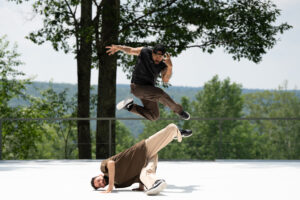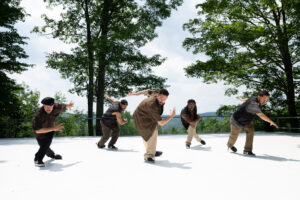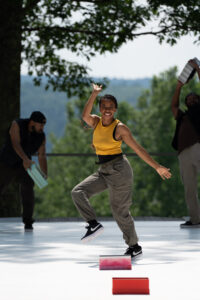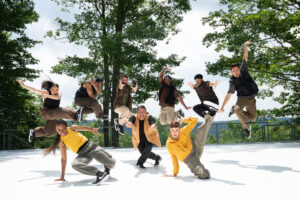
On July 13th, LA-based Hip Hop company Versa-Style Dance Company visited The Pillow for a performance and a free community workshop in Pittsfield. Our Audience Development Intern, Tadea Martin-Gonzalez sat down with Versa-Style principal dancer and touring manager Brandon (“Beast Boi”) Juezan to talk about the company, its mission, and the role that Hip Hop culture and community plays as a role in every part of the work that they do.
Can you talk about Versa-Style Dance Company’s origins?
“Yeah, so to backtrack, what inspired the inception of our company was our directors Jackie Lopez and Leigh Foaad. They just saw that what we did in the Hip hop and street dance community was like underrepresented, and that the communities that we come from a lot of the dances from those communities were never seen on stage, maybe in the industry in the early 2000s, late 90s, those kinds of styles were out but in a lot of prestigious professional settings, we didn’t ever see what we did. So really, the inspiration was to take the dancers from our communities, namely Black and Latino, street and social dance forms, and bring them to the concert stage. So we do that with the hopes that we empower folks who look like us and come from similar communities as us to say “Oh, okay, I don’t have to look and dance a certain way to be represented in this space. I can do dances from my neighborhood. I could do dances from my family, and still be respected and still be able to be a professional and still have this art form appreciated.’ “

Concert dance comes in many forms, and many of them are hostile to Black and Latine communities. When performing in these spaces what are the goals of the company and what audiences are you looking to perform for?
“Our approach is generally similar, but it shifts depending on the audience. We’re very flexible and have performed everywhere from hometown LA, where there are lots of people of color, to Lee, Massachusetts where racial diversity isn’t as much (at the forefront), but it’s not a problem. We actually love to share what we do and our culture, because like you said, these spaces have traditionally not considered what we do to dance or to dance form. They’ve always kind of put Eurocentric forms at the forefront and held those in high regard, while more informal dance styles, dance styles that use improvisation more than formal structure, have always been seen as lesser. What we have done is we’ve tried to take those street dance forms and include elements of high quality professionalism, in terms of the way we put our shows together. The movement is true to the foundation for the styles that we do, but it’s high level. We’d like to push the boundaries of the movement and the music that we use, and not be a spectacle. There is an expectation to just go do backflips and hype up the crowd. Instead we want to show that we can take our street dance forms and still tell a story and evoke the same emotions and responses that traditionally, ballet and contemporary companies have utilized on stage.
So that’s really our goal. We want to show that street dance can be a powerful dance form that can evoke emotion and expression. It can be artistic, it can be quality and it shouldn’t be considered as lesser or other. It’s just as good. It’s just different.
So that’s really what our main goals are. Of course, we also want to make sure that we’re educating audiences on the different sides of Hip Hop and street dance culture, because there’s also a very mainstream (and often negative) idea of what Hip Hop is. We’re trying to show how within Hip Hop there is community, there’s love, there’s fun, there’s artistic quality. So that’s kind of our goal when we travel to these spaces.”

You mentioned the stories you hope to tell with movement – what is the story that you told with this particular show?
“So our story is about oppression, like financial burdens, and family separation that are a part of growing up in a family in an underserved BIPOC community and finding hope – that’s why the show is called Box of Hope. We have these boxes, and the idea is at the beginning, we have boxes and we open them and it’s like Pandora’s box. So then all the negativity that you see in the world comes out of the box and starts spreading everywhere. It causes all this family drama and conflict. But then, in the story of Pandora’s Box, once all the negativity comes out the only thing left is hope so at the very end of the show, our goal is to kind of come together, and hold on to the hope that’s left in those boxes to move forward. “
Can you talk a little bit about the role that community plays in the work that the company does?
“Our organization was born out of a love for community. I think one thing that is very different with a lot of these street dance forms or just general social dance forms is that there are niche communities built around, doing the styles. Like I’m not sure if there’s so much of a community with more traditional Eurocentric styles. I think it’s more like studios and schools and that kind of culture versus it being like “we all get together in a space and hang out and dance and have fun and talk and make friends with these people”.
Community is the basis for really all the dance styles that we do. All these stencils were developed within communities – they weren’t developed in formal settings, so community is kind of the heart of what we do. If we didn’t really have a dance community, if we didn’t have our students back home, or if we didn’t have other dancers who were inspired to form their own communities from what we do, we wouldn’t really be doing this work.
Community inspired us to do this work to begin with. It’s like “Hey, we’re a group of folks who love what we do. We want to provide a service. We want to give more opportunities to our community to put them on the map, and to learn and grow and excel at this thing that we love called hip hop and street dance.” So that is kind of like what has inspired us since the beginning is community versus it just being a prestige of like, “we’re a dance company like now we can let all that go”. Of course we want to be respected as a dance company and a dance organization. But really at our core it’s the community that helped build us and that’s what we’re trying to give back to.”

In an era when students, especially students of color, are expected to confound to pretty rigid expectations, what do you see as the role of Hip Hop and Hip Hop culture both in schools and just for youth more generally?
“So one thing that Hip Hop promotes is freedom of individual expression – that’s what makes it unique compared to a lot of other art forms or dance forms. There’s history, there’s Foundation, there’s culture, but you make it your own. So learn the basics and then find your own path within this culture. So when we work with students to go into schools, one of the biggest things we always teach them is like we’re not here to make you look like us. We’re not here to make a bunch of little Versa-Style clones to go off and carry out our mission. It’s not OUR mission. It’s the mission of Hip Hop and Hip Hop culture. We just honed in on a particular way of doing it, and that’s what our company focuses on.”
You touched on the 50+ years of culture that inform what is happening now. 50 years of ancestors, 50 years of knowledge that comes into each and every performance. While holding onto that, what are the company’s hopes for the future?
“Yeah, we talk about this a lot. I think a lot of our hope for the future is that it doesn’t stop with us. I mean, our company was built off and inspired by Rennie Harris Puremovement , since he set the stage for Hip Hop as a concert dance form. Our hope is just to continue that legacy and then inspire the next generation to continue to create something new, and to continue even when we stop. Most of our members in the Versa-Style touring company, we’re getting into our 30s and 40s,and we’re going to be doing the dancing for a while, but we also need to like, push the progress of the culture for the next generation, the teenagers, the 20 year olds, they’re going to be carrying the torch in the future. So we just want to make sure that the torch bearers have been inspired. They have knowledge and then they go and they take that forward.”
Anything else you want to share?
“Nope! This is our third time with Jacob’s Pillow and we hope that the community is starting to get to know us, and that people continue to come to our shows with open hearts and open arms. We’re excited for what the future holds!”
For more about Versa-Style Dance Company, visit them at their website or follow them on Instagram @versastylela, or Facebook at Versa-Style Dance Company
This Pillow Pick was Edited by Tadea Martin-Gonzalez and published on July 18th, 2023.